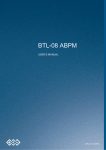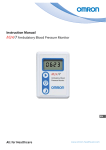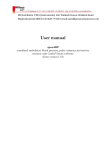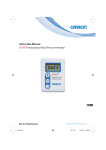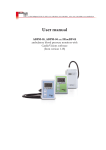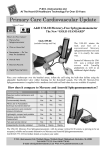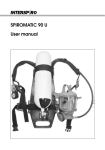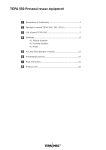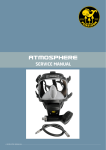Download User guide for Meditech ABPM-05
Transcript
Meditech ABPM-05 ambulatory blood pressure monitor User manual Important information – precautions for use – read carefully! This symbol on a Meditech recorder is a warning that you should read the accompanying documentation (this manual). The ABPM-05 ambulatory blood pressure recorder is manufactured by Meditech Ltd. 200 Ulloi ut, Budapest, Hungary fax: +36 1 282 9388 www.meditech.eu e-mail: [email protected] Contact us for further product and service information. Meditech Ltd. maintains a quality assurance system certified according to MSZ EN ISO 9001:2000 and MSZ EN ISO 13485:2003. Notified Body Unit 202b, Worle Parkway Weston-super-Mare, BS22 0WA ! ABPM-05 recorders should not be used if any of the following cases apply: • patients without an indication for ambulatory blood pressure monitoring • non-cooperative patients • patients in any way unable to operate a recorder as intended • patients requiring urgency / emergency cardiac care • unconscious or otherwise incapable patients • patients with serious mobility impairments without supervision • patients with coagulation disturbances • children without supervision • children under the age of 8 years ! Though the blood pressure measurement algorithm used in ABPM-05 recorders has been tested and found to function properly on patients with atrial fibrillation or other common arrhythmias, the oscillometric blood pressure measurement method is generally recommended for use only with special caution in patients with arrhythmias, Parkinson's disease, or other diseases with tremor. ! Always consult a physician for the interpretation of the blood pressure measurements. Note that any blood pressure recording may be affected by the body position, the physiological condition of the patient, and other factors. model BP5 2 SGS Yarsley fax: +44 1934 522 137 www.sgs.com Device type. ABPM-05 described in this manual complies with the requirements of the EU Medical Devices Directive (93/42 EEC). 0120 is the identifier of Notified Body (SGS UK) MDD IIa MDR II MDD classification IIa. EMC class B. EMC group 1. According to Canadian regulations the device classification is MDR II. (Medical Device Regulation of Canada, Rule 10.1 of MDR (SOR/98282:13Mar2007)). ABPM-05 is an internally powered type CF device. Protection vs. ingress of water: none. Mode of operation: continuous. The device is not protected against defibrillators or other high frequency surgical equipments. YYYY/nnnnnn The first four digits of the serial number of a recorder show the year of production. The rest is the serial number. This symbol shows that according to regulations ABPM-05 should be handled as electronic waste during rollout. ! ! ! Blood pressure measurements determined with the algorithm of an ABPM-05 recorder on adults are equivalent to those obtained by a trained observer using the cuff/stethoscope auscultation method Korotkoff phase V, within the limits prescribed by the American National Standard for Electronic or Automated Sphygmomanometers. The algorithm used in the ABPM-05, similarly to the ABPM-04, also fulfills the requirements of the British Hypertension Society Validation Protocol for Automated Blood Pressure Measuring Devices. For information on cuffs and their application, see page 17. Take care to avoid blocking the air flow in the tube of the cuff and twisting the tube. Make sure the cuff and its tubing or the lead wires do not cause strangulation or a circulation problem. Should the patient experience arm numbness or pain remaining after any blood pressure reading is completed, the cuff should be removed to avoid permanent vascular or neural injury. No user serviceable parts inside. Meditech recorders contain high complexity electronic and fine mechanical components. If you have any problems, please refer your recorder to qualified service personnel. File ID: BP5E2211 3 --- This page is intentionally left blank --- 4 Table of Contents Table of Contents..........................................................................................................5 Recommended use of ambulatory blood pressure recorders.........................................6 Meditech ABPM-05......................................................................................................6 Accessories...............................................................................................................7 Using the buttons..........................................................................................................7 Display......................................................................................................................9 Technical parameters..............................................................................................10 Care and maintenance.................................................................................................11 Safety concerns...........................................................................................................12 Working with ABPM-05.............................................................................................13 Rules of monitoring................................................................................................13 Connecting the ABPM-05 recorder to the PC........................................................13 Monitoring step by step..........................................................................................14 Batteries..................................................................................................................15 Cuffs and their application.....................................................................................16 Meditech product warranty information.....................................................................17 EMC information........................................................................................................18 Notes...........................................................................................................................22 5 Recommended use of ambulatory blood pressure recorders Indications for ambulatory blood pressure monitoring The following indications are listed in the European Society of Hypertension recommendations for ambulatory blood pressure measurement, 2003. Suspected white-coat hypertension Suspected nocturnal hypertension To establish dipper status Resistant hypertension Elderly patient As a guide to antihypertensive drug treatment Type 1 diabetes Hypertension of pregnancy Evaluation of hypotension Autonomic failure Contraindications Non-cooperative patients, unconscious or otherwise incapable patients Patients requiring urgency / emergency cardiac care Patients with coagulation disturbances (for ABP monitoring) Patients with serious mobility or other impairments without supervision Children without supervision; children younger than 8 years Though the blood pressure measurement algorithm used in ABPM-05 has been found to function properly on patients with atrial fibrillation or other common arrhythmias, the oscillometric blood pressure measurement method is generally recommended for use only with special caution in patients with arrhythmias, Parkinson's disease, or other diseases with tremor Meditech ABPM-05 The ABPM-05 device is a compact, lightweight monitoring unit typically worn by the patient for 24 hours. ABPM-05 is a compact, LCD lightweight device, which operates with two AA START button size accumulators or batteries. The memory is capable of storing 600 measurements. Stepwise EVENT button pressure deflation ensures quality measurements, even if disturbing environmental DAY/NIGHT button factors occur. You may find the battery compartment and the rating label on the Cuff backside housing. The serial number is placed connection on the rating label, however it is also strored Interface electronically in the solid state memory of the connection device. On the front side of the housing, there is the LCD, the buttons of the device and a sticker displaying the name of the device. The device can be connected to the serial or USB port of an IBM compatible PC with an optoelectronic interface which has its socket positioned on the opposite side from the cuff connector. Patients can start extra blood pressure readings or mark symptomatic events. 6 Accessories set one one one one one four one one one one (1) (1) (1) (1) (1) (4) (1) (1) (1) (1) plastic or carton packaging (depending on order) ABPM-05 recorder unit serial or USB interface unit with twin optical cable pouch for recorder, with shoulder and waist straps normal adult size cuff AA rechargeable batteries battery charger CardioVisions software CD user manual declaration of conformity recorder package one (1) carton packaging one (1) ABPM-05 recorder unit one (1) pouch for recorder, with shoulder and waist straps one (1) normal adult size cuff one (1) declaration of conformity Accessories may vary from place to place. Using the buttons On the front side of the housing, below the LCD, you may find three buttons: the START button is marked with a triangle, the EVENT button marked by a heart and the DAY/NIGHT button indicated by a half moon. If the device is turned on, then every button press is accompanied by a short beeping sound. Cancel a blood pressure measurement The patient can interrupt a blood pressure measurement by pressing a button at any time while the cuff is inflated. This will result in immediate fast cuff deflation. Such interruption is limited to the measurement in progress only and has no effect on further operation. This function is available with all three buttons. Manual blood pressure measurement If it seems necessary, the patient can start an additional, manual blood pressure measurement by pressing the START button shortly. The result with a manual measurement marker will be stored in the memory of the device. Typical causes for this use: dizziness, pain (angina pectoris or headache), palpitation. Switching the device off Press and hold the START button for more than 10 seconds then release it when two horizontal segments appear on the LCD, this way ABPM-05 will be switched off. If you do not release the button in 2 seconds after the two horizontal segments appeared, the recorder will return to normal operation. This feature helps to avoid unintended poweroff. The device can only be switched on manually. While the recorder is switched off normal functions are not available, even prescheduled measurements will not 7 be triggered. Therefore switching off the device is only necessary in case of valid reasons. Switching the device on ABPM-05 is switched on to normal operation if the START button is pressed and held for more than 3 seconds. If the device is switched off, no other functions are available. LCD check Press and hold the START button to light up all segments of the LCD to check if they all work correctly. Battery voltage check Press and hold the START button for more than 5 seconds to display battery voltage on the LCD (e.g. 2_64, equal to 2.64 V). After checking the voltage, please release the button, because after additional 5 seconds, the device may turn off. The unit will then return to displaying time. The voltage for fully charged accumulators should be over 2.5 V, and for fresh alkaline batteries over 3 V. Set a patient event marker The patient can mark any event without starting a manual blood pressure measurement by pressing the EVENT button briefly. Typical causes for this use is taking medicine. The patient should be instructed to record the reason for setting an event marker in a diary. Mark time of going to bed and rising from bed If this function is disabled during programming, the patient can press the DAY/NIGHT button to mark the times of going to bed (in the evening) and rising from bed (in the morning). Manual DAY/NIGHT shift If this function is enabled during the programming, then the patient can manually shift the measurement frequency period (day or night) by pressing the DAY/NIGHT button. The shift is available in the two hour period before the prescheduled shift. 8 Display ABPM-05 will show important status information as well as the process and result of individual readings on its LCD. The most important displays are listed here. In addition to these most important displays, a lot of extraordinary situations and errors have their own code displayed on the LCD. These codes are stored together with recorded data and they are listed in the CardioVisions program. This helps service personnel to identify causes of an unexpected behavior, result or error. Normal status: time is displayed. Night mode: time is displayed, moon sign is lit. Blood pressure measurement initiated. Pumping for measurement current pressure [mmHg]. Deflation during blood pressure measurement, the current pressure is displayed [mmHg]. Heart symbol blinking in tune with pulse: measurement in progress. Systolic value of just completed measurement [mmHg]. Diastolic value of just completed measurement [mmHg]. Pulse rate value of just completed measurement [beats per minute]. Blood pressure measurement cancelled by pressing a button. Event marker set due to button push. The crossed battery symbol warns about low battery. Communication with personal computer. Error code display. LCD check: all segments are displayed. The recorder is switched off. Battery voltage display (2.37 V). 9 Technical parameters Power supply: Blood pressure measurement method: 2 AA rechargeable NiCd or NiMH batteries oscillometric or 2 AA alkaline batteries Blood pressure maximum storage: Display: over 600 measurements liquid-crystal Pressure measurement range: Data storage: 0-300 mmHg internal solid state memory Static accuracy: Data transmission: ± 3 mmHg or ± 2% of measured value on serial or USB optical cable, 115200Baud (stability: 2 years) PC interface: Blood pressure measurement range: special optoelectronic serial or USB 30-260 mmHg interface Pulse rate measurement range: Operating environment: 40-200 beat per minute Temperature: 10 - 45 °C Blood pressure measurement accuracy: Humidity: 10 - 95 %, non condensing same measuring algorithm as used in the Atmospheric pressure: 70 - 106 kPa ABPM-04, which has been validated Storage conditions: according to the BHS protocoll Temperature: -20 - 50 °C Pressure sensor: Humidity: 10 - 95 %, non condensing piezo-resistive Size: Inflation: 70 x 99 x 30 mm automatically controlled pump Weight: Safety: app. 240 g (batteries included) maximum inflation 300 mmHg; independent safety release valve Deflation and rapid air release: automatic pressure release valve Please note that the ABPM-05 might not meet its performance specifications if stored or used outside the specified environmental conditions. 10 Care and maintenance Protection and cleaning ABPM-05 ambulatory blood pressure recorders are not specially protected against spills or ingression of water or other liquids. Do not immerse the recorder in water or any cleaning fluid, and protect it from spills and splashes. Do not expose it to heavy rain or steam, and do not wear it in a wet environment e.g: shower, bath, or swimming pool. In case of minor effects of a wet environment, wipe off water drops with a dry cloth. Keep the recorder in a normal dry room for at least one hour before use if condensation is suspected. In case of ingress of water in the recorder, remove batteries from the unit, and refer the unit to authorized service. Never place a recorder unit in a disinfecting or sterilizing machine! A recommended means of cleaning is to wipe the recorder with a disinfectant cleaning tissue, e.g., Henkel Ecolab Incides, or a similar product. Alternatively, wipe with a slightly damp cloth then dry it with an antistatic tissue. Do not expose recorders to extreme heat or radiation, including long exposure to direct strong sunlight. Regular checks, warranty, service Verification of pressure measurement accuracy is recommended biannually. ABPM-05 recorders are covered by a two-year warranty under general warranty conditions of Meditech Ltd, see relevant section. This warranty does not cover any malfunction or defects arising from improper use, the use of inadequate accessories, accident, theft, or use of the device outside operating environmental specifications or intended measurement range. Removing the closing label from the back side of the device voids this warranty. There are no user serviceable parts inside Meditech recorders; they contain high complexity electronic and fine mechanical components. If you have any problems, please refer the recorder to qualified service personnel. Contact Meditech or your distributor for service information. Roll-out ABPM-05 recorders include an internal NiCd coin cell which may fall under the category of hazardous waste and should be disposed of properly. The device should be handled at roll-out as normal electronic waste. 11 Safety concerns Electric shock hazard protection ABPM-05 recorders meet relevant shock hazard protection standards. ABPM-05 recorders operate with two 1.5V AA batteries or two 1.2V AA rechargeable batteries. This excludes all electric shock hazards, even in the unlikely case of multiple device errors. Use only standard long-life (alkaline) batteries, or standard NiCd or NiMH rechargeable batteries of the proper size. Do not use lithium batteries. Do not mix different battery types, do not mix new and old batteries, do not use damaged batteries. Many personal computers do not meet certain shock hazard protection standards or strict safety regulations applicable to medical devices. Therefore, during the computer-based use of Meditech recorders, keep at least a 2 meter distance between patient and computer. This is the required minimum safety distance. ABPM-05 recorders communicate using a plastic optical cable, whose 4 m standard (and up to 10 m optional) length allows for the required safety distance. The plastic optical cable ensures perfect electric separation and reduces the effects of external electric noise. It does not conduct electricity. Biocompatibility To avoid infection risks, and for general hygienic reasons, the device, cuff and tubing should never contact the patient's skin directly. Hazardous materials Used batteries qualify as hazardous waste and should be disposed of properly. Meditech recorders do not contain any materials qualified as pharmaceutical substance or tissue of animal origin. They emit no material hazardous to humans. Risk of incorrect diagnosis The basic intended use of ABPM-05 recorders is to record blood pressure and pulse rate values. Patients should be informed about rules of cooperative behaviour, proper handling of the recorder used, and expected results of monitoring in advance. ABPM-05 recorders only provide data to support diagnostic decisions of a qualified physician, they do not automatically provide a diagnosis of any kind. During the evaluation of recorded blood pressure values, possible artefacts due to external disturbances, motion artefacts, and electrical noise should be observed and handled with caution. 12 Working with ABPM-05 The recorder must be programmed with the CardioVisions software installed on the computer. Once the pre-programmed time is reached, the recorder will commence operating automatically and perform blood pressure measurements based on the monitoring plan. To obtain reliable BP readings, certain rules must be observed. Rules of monitoring 1. Inform the patient about the goal and expected results of the monitoring. Provide an event diary and rules to observe. 2. Patients can fit the recorder comfortably with the adjustable straps. 3. It is advisable to wear a thin shirt under the ABP cuffs. This does not influence the accuracy of blood pressure measurement, but it prevents problems caused by longtime wear of the cuff (sweat, itching, soreness, etc.). 4. The cuff should be properly placed and connected. 5. Patients should avoid excess movement during blood pressure measurements. They should hold their arm loose, slightly away from their chest. 6. Should the blood pressure measurements cause bloodshots, torpidity or pain in the hand, the cuff should be removed from the arm immediately and disconnected from the recorder. Such occurrence should be reported to the physician latest after the monitoring session. 7. Patients should not remove the recorder even at night. By loosening the straps, they can avoid problems when turning in their sleep. The recorder does not disturb most patients at night. 8. Patients may start extra blood pressure measurements with the START button of the ABPM-05 recorder, marked with a triangle. They should mark events such as taking medication with the EVENT button, marked with a heart. They should also mark the time of going to bed and rising from bed, with the DAY/NIGHT button marked with a crescent moon. They may interrupt any single blood pressure measurement if necessary by pressing any button. 9. Should the batteries run down during a monitoring session, they can be simply replaced. Monitoring will continue, and data will not be lost. 10. Patients should never measure anybody else’s blood pressure with an ABP recorder during an ambulatory blood pressure monitoring session. Connecting the ABPM-05 recorder to the PC Please connect the optical interface, which was delivered with the device, to the serial (RS232, 9-pin connection) or USB port of the PC. The other side of the interface cable, which is a two-point plastic connection, should be connected to the socket of the ABPM-05, in a way that the red plastic ring is directed to the lower side of the device. 13 Start the CardioVisions software and open the Options menu, then click on the Communication tab on the left side of the screen. On the appearing window, select ABPM-05 on the right side and then click on the Meditech USB or on the Serial port options, dependent upon your interface. In case of a serial port, please provide the ID of the serial port (COM port) to which you connected the device. If you are unable to do so, then tick the Auto search com port option. In order to check the communication please connect the device to the PC (charged batteries, device switched on) in the above mentioned way and then click on the Test button. If the communication was successful then the software will display the serial number and the firmware version of the device. Monitoring step by step Before you begin, you must have the CardioVisions software properly installed and configured on your computer, and the recorder correctly connected. To program your recorder, you will need a Meditech optical interface cable properly connected to your computer's serial or USB port (or to a USB port using a standard USB-to-serial converter) and the communication port correctly selected in the CardioVisions software. A successful monitoring session consists of the following steps: 1. 2. 3. 4. 5. 6. 7. 8. 9. Inform your patient about monitoring rules well in advance. Start the CardioVisions program, select the ABPM-05 recorder type. Enter new patient data or select patient from the database. Create a monitoring plan with respect to the patient's lifestyle. Insert two fully charged, AA size batteries into the battery compartment and check their voltage. Connect the recorder to the computer. Send the monitoring plan from the computer to the recorder unit. Apply the cuff to the patient with the device placed in the pouch. Give the patient diary to the patient along with detailed instructions about the rules and the usage of the device. --- Monitoring session (typically 24 hours) --10. Remove the unit and cuff from the returned patient. 11. Ask for the patient diary, and ask the patient for any events, symptoms, observations or complaints. 12. Start the CardioVisions program and select the ABPM-05 recorder type. 13. Connect the device to the PC and then transfer collected data from the recorder to your database. 14. Analyze the blood pressure profile. 15. Create and print a report. 14 Batteries ABPM-05 ambulatory blood pressure recorders operate with two 1.5V AA batteries or two 1.2V AA rechargeable batteries. Use only standard long-life (alkaline) batteries, or standard NiCd or NiMH rechargeable batteries of the proper size. Do not use lithium batteries. Do not mix different battery types, do not mix new and old batteries. Never use batteries of low or unknown quality or pre-used batteries, as they may not cover the power needs of the recorder, and they may damage the recorder, or they may contain acidic electrolytes which may leak and corrode electronic components. Never use batteries damaged in any way. Should the batteries run down during a monitoring session, they can be replaced. Monitoring will continue and data will not be lost. If you do not use the recorder, it is advisable to remove batteries since they may run down due to the constant small power consumption of the integrated circuits of the device. Data in the recorder are not lost even if batteries run down or are removed. Used batteries may fall under the category of hazardous waste and should be disposed of properly. Important! It is strongly recommended to use freshly charged accumulators or new batteries with every patient so that batteries do not run down during monitoring, even in case of very high blood pressure values and/or a long monitoring session. After inserting batteries in ABPM-05 recorders, it is advised to check their voltage before programming the recorders. Do not start a new monitoring session with low batteries. The typical voltage for two fully charged rechargeable batteries should be over 2,5 V, and for fresh alkaline batteries, over 3 V. It is possible to check battery voltage with the START button. (Please check the Using the buttons section for more details.) Important! If a recorder is not used for a long period, the in-built backup cell ensuring the operation of the internal clock may get discharged. In this case keep freshly charged batteries in the recorder for at least one day; this will recharge the backup cell. It is possible to use the recorder afterwards. If the backup cell is not properly charged, the internal clock may work incorrectly, and the recorder may not start measurements in due time. Two sets of rechargeable batteries and a charger are by default included in the complete set. Please refer to the relevant product descriptions when charging batteries. A set of properly charged, high capacity batteries will enable an ABPM-05 recorder to perform 250 blood pressure measurements during a 24-48 hours long monitoring session. If you opt to use alkaline batteries, choose high capacity, long-life products to enable reliable operation. A small crossed battery sign on the LCD shows low battery voltage. In order to change batteries, take the recorder out of the holder pouch and remove the battery compartment cover on the back-side. Place two properly charged, high capacity AA rechargeable or two new, long-life AA alkaline batteries into the compartment as shown in the polarity drawing. Close the compartment. 15 Cuffs and their application It is advisable to wear a thin shirt or blouse under the cuff. This does not influence the accuracy of blood pressure measurements but it prevents possible problems caused by long-time wear (sweating, itching, etc.). Place the cuff on the upper arm so that the rubber tube points towards the patient’s shoulder and the bladder is placed above the brachial artery, if possible. Contrary to the usual placement with the tube pointing downwards, the advantage is that the patient can wear a loose jacket over the cuff. Connect the rubber tube of the cuff into the air plug connector, which you can find on the long edge closer to the buttons of the ABPM-05 recorder. Connect the cuff turning it clockwise with slight pressure. Note: It is recommended that the cuff be applied as tightly as acceptable for the patient. A too loose cuff will cause much longer blood pressure measurement times and possibly aborted measurements. With an overly loose cuff, the recorder must pump to tighten the cuff on the arm and then it must reach the pressure necessary for measurement. This causes considerable inconvenience for the patient and results in less data for evaluation. If the patient removes the cuff for a period during the monitoring session, it should be re-applied with appropriate tightness, with help from another person, if necessary. Should blood pressure measurements cause bloodshots, torpidity or pain in the hand, the cuff should be removed from the arm and disconnected from the recorder. Such occurrence should be reported to the physician at once but latest after the monitoring session. Meditech ABPM-05 recognizes and functions with three different cuff sizes. Please set the appropriate cuff size to be used during the programming of the device. Attention, inappropriate setting of the cuff size may lead to device malfunctioning, which is inconvenient for the patient and may lead to an unsuccessful measurement. Name Normal adult Small adult (child) Large adult Bladder dimensions 12.5 x 22.5 cm 6 x 28.5 cm 14.5 x 32 cm Sleeve dimensions 16 x 52 cm 9 x 41 cm 16 x 70 cm Arm circumference range* 24-32 cm under 24 cm 32-42 cm * When properly applied, the end of the sleeve (the one closer to the tube) should fall in the indicated range. The cuff is the component which, by definition of the relevant standard, is protected against a defibrillator discharge. Caution! Substitution of a cuff different from that supplied might result in measurement error and/or in certain cases cause damage to the main recorder unit. 16 Meditech product warranty information (a) RECORDER WARRANTY. The main recorder unit will be free from defects in materials and workmanship under normal use and service for a period of two (2) years from the date of receipt. This warranty covers the recorder unit only. This warranty does not cover any accessories that might come with the recorder unit. (b) ACCESSORIES WARRANTY. The non-disposable accessories delivered with the recorder unit will be free from defects in materials and workmanship under normal use and service for a period of one (1) year from the date of receipt. This warranty does not cover disposable accessories, packaging materials, accumulators and batteries, cuffs, or any of their components. (c) CUFF WARRANTY. The cuff(s) - if delivered with a recorder unit - will be free from defects in materials and workmanship under normal use and service for a period of six (6) months from the date of receipt. This warranty covers the cuff(s) delivered with a recorder unit exclusively. (d) SOFTWARE WARRANTY. The CardioVisions software under normal use will perform substantially in accordance with the accompanying written/electronic documents for a period of ninety (90) days from the date of receipt. This warranty is valid at the representative address of Meditech Ltd. unless otherwise displayed upon a commercial invoice or any other valid business document duly signed by the supplier and the recipient of the Meditech product. If such business document displaying a certain site for warranty validity cannot be presented, this warranty is valid at Meditech HQ office in Budapest, Hungary. This warranty does not cover any malfunction or defects of the recorder unit or any of its accessories arising from improper use, the use of inadequate accessories, accident, theft, or use of the recorder unit outside its operating environmental specifications and intended measurement range. Removing the closing label from the back side of the recorder unit, or opening the unit any other way voids this warranty. EXCLUSION OF BIOHAZARD. Meditech will not accept for repair potentially infectious products or accessories, especially pouches and cuffs, that might have been in direct contact with the patient, and could not be, or (potentially) were not, properly disinfected, even within the warranty period. If a problem occurs within the warranty period, such accessories will be replaced without any physical inspection, reserving the rights to hold an inspection when found necessary. NO OTHER WARRANTIES. Meditech disclaims all other warranties, either expressed or implied, including, but not limited to, implied warranties of merchantability and fitness for a particular purpose, with regard to the recorder unit, any accessory or other accompanying hardware, and the CardioVisions software. NO LIABILITY FOR CONSEQUENTIAL DAMAGES. In no event shall Meditech be liable for any special, incidental, indirect, or consequential damages whatsoever (including, without limitation, damages for loss of business profits, business interruption, loss of business information, loss of data, or any other pecuniary loss) arising out of the use of or inability to use the recorder unit, its accessories and/or the CardioVisions software, even if Meditech has been advised of the possibility of such damages. 17 EMC information Medical electrical equipment should be used with precautions according to EMC, and must be installed according to the EMC notices disclosed in this manual as mobile RF transceivers could adversely affect it. Directive and declaration of manufacturer – Electromagnetic Emission ABPM-05 is suitable for use in the specified electromagnetic environment. The purchaser or user of Meditech ABPM-05 should assure that it is used in an electromagnetic environment as described below Emission test Compliance Radiated and conducted Group 1 RF emission CISPR 11 Radiated and conducted Class B RF emission CISPR 11 Harmonic emission Electromagnetic Environment ABPM-05 uses RF energy only for its internal function. Therefore, the emission is very low and not likely to cause any interference in nearby electronic equipment. ABPM-05 is suitable for use in domestic establishments and in establishments directly connected to the low voltage power supply network which supplies buildings used for domestic purposes. Not applicable --- Complies ABPM-05 is suitable for use in establishments directly connected to a public low voltage mains network. IEC61000-3-2 Voltage fluctuations / Flickers IEC61000-3-3 18 Directive and declaration of manufacturer – Electromagnetic immunity ABPM-05 is suitable for use in the specified electromagnetic environment. The purchaser or user of Meditech ABPM-05 should assure that it is used in an electromagnetic environment as described below. Immunity test Electrostatic discharge (ESD) IEC601-1-2 test level ±6KV contact Compliance level ±8KV air Floors are wood, concrete or ceramic tile, or floors are covered with synthetic material and the relative humidity is at least 30 percent. Not applicable Mains power quality is that of a typical commercial and/or hospital environment. Not applicable Mains power quality is that of a typical commercial and/or hospital environment. Not applicable Mains power quality is that of a typical commercial and/or hospital environment. If the user of Meditech ABPM-05 requires CLINICAL UTILITY during power mains interruptions, it is recommended that parts of the Meditech ABPM-05 system where applicable be powered from an uninterruptible power supply. 3A/m Power frequency magnetic fields are at levels characteristic of a typical location in a typical commercial and/or hospital environment. ±8KV air IEC 61000-4-2 Electrical fast transient/ burst ±2KV for power supply lines IEC 61000-4-4 ±1KV for input/output lines Surge ±1KV differential mode IEC 61000-4-5 ±2KV common mode Voltage dips, short interruptions and voltage variations on power supply input lines IEC 61000-4-11 Power frequency (50/60Hz) magnetic field <5% UT (>95% dip) for 0.5 cycle; 40% UT (60% dip) for 5 cycles; 70% UT (30% dip) for 25 cycles; <5% UT (>95% dip) for 5 sec. 3A/m Electromagnetic environment IEC 61000-4-8 Note: UT is the nominal voltage of mains. 19 Directive and declaration of manufacturer – Electromagnetic immunity Meditech ABPM-05 is suitable for use in the specified electromagnetic environment. The purchaser or user of Meditech ABPM-05 should assure that it is used in an electromagnetic environment as described below. Immunity test Conducted RF IEC 6100-4-6 IEC601-1-2 test level Compliance level 3Veff Not 150KHz - 80MHz applicable Electromagnetic environment Portable and mobile RF communications equipment are used no closer to any part of Meditech ABPM-05, including cables, than the Recommended Separation Distance calculated the formula written below. Recommended Separation distance: d=[3,5/V1]√P Radiated RF 3V/m IEC 61000-4-3 80MHz – 2,5GHz 3V/m d=[3,5/3V/m]√P; (80MHz – 800MHz) d=[7/3V/m]√P; (800MHz – 2,5GHz) where: P is the highest radiated power disclosed by the manufacturer of transmitter [W]; d is the recommended separation distance [m]. 1. note: in case of frequency 80MHz or 800 MHz, the formula for the higher range is applicable. 2. note: These are guidelines. Actual conditions may vary. 20 Recommended separation distance ABPM-05 is intended to be used in electromagnetic environment with controlled RF disturbances. The purchaser or user of ABPM-05 may help to reduce electromagnetic disturbances by defining the separation distance between the transportable or mobile RF telecommunication equipment (transmitters) and ABPM-05, depending on the highest output power of the telecommunication equipment. Separation distance in function of the frequency of the transmitter [m] The highest output power of the transmitter [W] 150KHz – 80MHz 0,01 Not applicable 0,12 0,23 0,1 Not applicable 0,38 0,73 1 Not applicable 1,2 2,3 10 Not applicable 3,8 7,3 100 Not applicable 12 23 d=[3,5/V1]√P 80MHz – 800MHz 800MHz – 2,5GHz d=[7/E1]√P d=[3,5/E1]√P If this table does not contain the highest output power of the transmitter, the d separation distance [m] can be calculated by the formula, depending on the frequency of the transmitter, where P is the rated highest output power of the transmitter [W]. 1. note: in case of frequency 80MHz or 800 MHz, the formula for the higher range is applicable. 2. note: These are guidelines. Actual conditions may vary. 21 Notes 22























